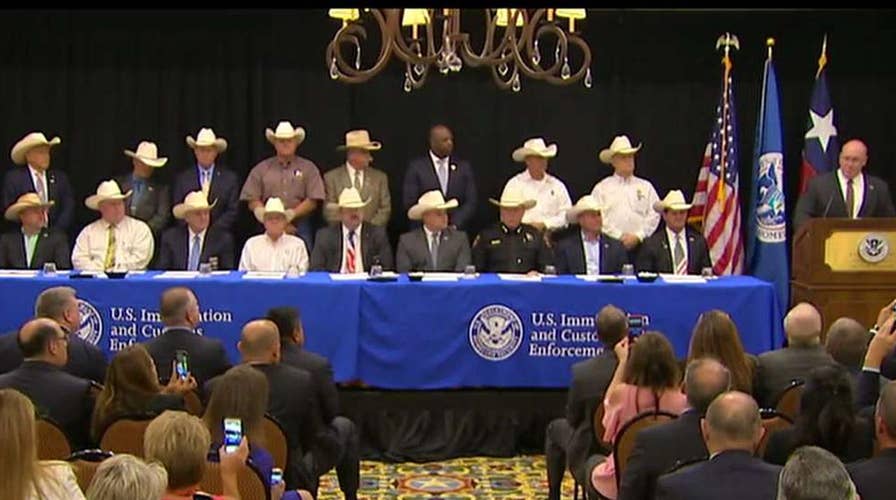The acting director of the Immigration and Customs Enforcement agency signed more than a dozen agreements with local Texas law enforcement entities on Monday, giving them the authority to perform certain functions as federal immigration agents.
Thomas Homan, who took over as the acting director of ICE in January 2017, signed 18 new agreements with Texas law enforcement agencies to allow officers to interrogate individuals who have been arrested on their immigration status. Officers also will be able to place detainers on individuals.
“It is common sense partnerships like these that help law enforcement achieve our mutual goals, and I’m encouraged by the increased interest from law enforcement professionals who seek to join this program and protect public safety,” Homan said in a statement.
The 287(g) program – which became law as part of the Illegal Immigration Reform and Immigrant Responsibility Act in 1996 – enables state and local law enforcement entities to collaborate with and perform functions of federal immigration agents.
“The 287(g) program is extremely helpful as it allows local law enforcement agencies to participate as an active partner in identifying criminal aliens in their custody, and placing ICE detainers on these individuals,” Matthew Bourke, a spokesman for ICE, told Fox News. “Removing criminal aliens from our communities produces a higher level of public safety.”
The 18 Texas law enforcement agencies – 15 of which are in the Houston area – will be deputized only under what is called the “jail enforcement model” of the 287(g) agreement.
“Under the [agreement], local law enforcement is not expected to determine the immigration status of individuals during the course of daily activities,” Bourke said. “Only when they process someone into a detention facility.”
ICE CHIEF READIES NATIONAL SANCTUARY CITY CRACKDOWN
One problem with the “jail enforcement model” is at what point information is shared with federal immigration officials, said Royce Murray, the policy director at the nonprofit American Immigration Council.
“In our criminal justice system, somebody is innocent until proven guilty, and the information-sharing that happens in this context is at the arrest stage, not at the conviction stage,” Murray told Fox News. “There could be some overlap between someone who is convicted and who presents a public safety threat, but you don’t know that until the end of the process, and the information-sharing is at the beginning.”
For example, Murray said, police could be called to investigate a domestic violence situation and encounter two people who don't speak English well with physical injuries. Both could be arrested before officials determine that the woman was simply defending herself against an attacker.
“But by that point, the information-sharing with ICE has happened,” she said.
IMMIGRATION OFFICIALS CONTINUE ENFORCEMENT EVEN IN CITIES HOSTILE TO THEM
Murray also critiqued the program’s “diversion of resources.”
“Any work that local police are doing to enforce immigration law means they’re not spending their time pursuing other public safety matters,” Murray said.
Trump signed an executive order in January which called for the beefing up of the 287(g) program.
“It is the policy of the executive branch to empower state and local law enforcement agencies across the country to perform the functions of an immigration officer in the interior of the United States to the maximum extent permitted by law,” the order states.
A few days before Trump signed the order, Jackson County Sheriff A.J. “Andy” Louderback, who attended Monday’s ceremonial event, signed a Memorandum of Agreement (MOA) with ICE.
So far, ICE has signed agreements with 60 law enforcement agencies in 18 states – including the agencies that participated in Monday’s event.
The agencies that signed Monday won’t immediately be a part of the program, Sarah Rodriguez, a deputy press secretary at ICE, told Fox News. Officers will need to be selected and undergo a month-long training process. Additionally, ICE supervisors will be assigned to oversee the agencies in the 287(g) programs.
“Free reign is not the case,” she said, predicting it would take one year before the agencies are “operational” with the program.
ICE ARRESTS 114 IN NEW YORK STING OPERATION
Rodriguez stressed that the programs shouldn’t disrupt the communities in which they are in place because law enforcement officials will be deputized only for those “brought to jail for criminal activity.”
“That’s the beauty of this program. It doesn’t involve activity that would disrupt the community,” Rodriguez said. “The community can expect fewer criminals persisting on the streets and causing problems.”
But Murray argued that a partnership between ICE and local law enforcement officials could deter people from reaching out to report a crime as they could be worried about their own immigration status or a family member’s.
287(g) agreements have been signed in Alabama, Arizona, Arkansas, California, Florida, Georgia, Louisiana, Maryland, Massachusetts, Nevada, New Jersey, North Carolina, Ohio, Oklahoma, South Carolina, Tennessee, Texas and Virginia.
Other agreements under the law included a “task force model” which enabled officers to question and arrest people believed to have violated immigration laws and the “hybrid model” which combined the “task force model” with the “jail enforcement model,” according to the American Immigration Council. The task force model was discontinued in 2012, but immigration activists worry it could be reinstated.





